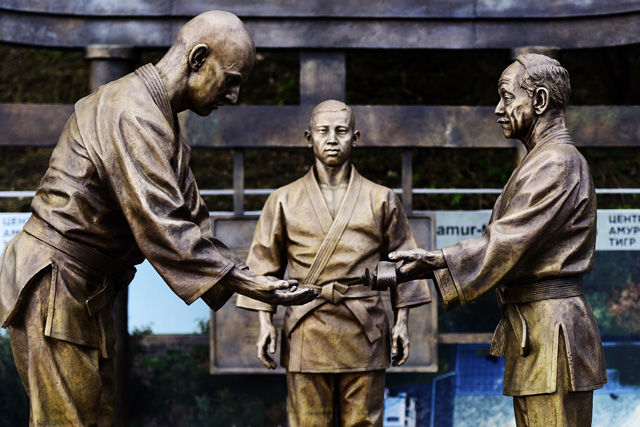A History of Sambo: Oshchepkov, Spiridonov and the Soviet Struggle

A
memorial honoring Vasili Oshchepkov in Korabelnaya Embankment.
(Photo: Yuri SmityukTASSGetty Images)
Vasili Oshchepkov was born in Sakhalin, Russia, in 1893 and became an orphan at only 8 years old. After the transfer of South Sakhalin to Japan under the Treaty of Portsmouth in 1905, Oshchepkov was sent to the Land of the Rising Sun to continue his studies two years later. After a few years studying traditional Japanese judo under St. Nicholas of Japan, Oshchepkov was sent to the famous Kodokan Judo Institute in 1911 -- an institution founded by the man who created judo: Jigoro Kano. Six years later, Oshchepkov passed his exams and became the first Russian in history to receive a second-degree black belt in judo.
After receiving his black belt from Kano, he moved back to Russia and founded the first Russian Judo competitions, which ran from 1914-20. In 1921, Oshchepkov moved back to Japanese-controlled Sakhalin to inherit land and houses from his deceased father, who died in 1902. Because Sakhalin was under Japanese control, he was forced to work for the Japanese as a translator in order to inherit the land. This began his ties to the Japanese military.
Advertisement
Stalin and the Soviet Union chose two men to develop this new system. Oshchepkov was one. The other was Viktor Spiridonov, who had an extensive background in wrestling. Spiridonov focused on techniques that he could perform in his limited physical state due to bayonet injuries suffered in WWI, similar to what Carlos and Helio Gracie were doing with jiu-jitsu at the same time in Brazil. Oshchepkov focused on taking the most effective techniques from various martial arts and combining them into one. He took the throws and trips from judo, strikes from traditional Ryukyu karate, submissions from Japanese jiu-jitsu and grappling techniques from folkstyle wrestling. Oshchepkov brought his knowledge of the various martial arts to the Dynamo Club, where Spiridonov’s soft style of combat was being taught. During these years, Oshchepkov and Spiridonov occasionally collaborated on techniques and eventually led to the development of what they called “Self Defense Without Weapons,” or sambo for short.
Although Oshchepkov and Spiridonov were the pioneers of this new self-defense method, they rarely crossed paths and only occasionally got together to collaborate. Eventually, they had a falling out: Spiridonov wanted to keep sambo a military-only system, while Oshchepkov was dedicated to making it a national sport. During the 1920s and 1930s, they both taught this new system to various sectors of the Red Army, and sambo became the official hand-to-hand combat system of the Soviet military forces. During this time, Oshchepkov held competitions to further tweak and adapt this new system for the military’s needs and the national sport he hoped to create. Again, it was similar to what the Gracies were doing in Brazil.
Stalin’s paranoia and anxiety were well-documented during this time, and in his 30 years in office, he deployed an almost constant hunt for spies and double agents in Russia. In 1937, Oshchepkov’s ties to the Japanese led to Soviet suspicion that he was a spy. He was sent to a Siberian prison, where he was later shot and killed for his ties to Japan. While he was forced to work as a translator for the Japanese at one point, he never -- despite being accused -- worked for the Japanese military intelligence. In the classic Soviet way, his death was ruled a heart attack despite the bullet in his head.
In a time when getting access to information was no easy task, Oshchepkov’s main goal in life was to travel the world, learn about martial arts and share his findings with his beloved home country. He was killed because of it. After his death, the Soviets wanted to disband sambo because of its Japanese ties, but one of Oshchepkov’s students, Anatoly Kharlampiyev, ended up being the saving grace for the country’s prized sport. Using his political affiliations, he managed to convince the USSR State Sports Committee to adopt sambo as the official martial art of Russia in 1938.
Today, sambo has three variances. Sport sambo is grappling-based, with a focus on leg locks, trips, throws and ground transitions while not allowing chokes and various other joint submissions. Combat sambo is similar to modern MMA, apart from still allowing groin strikes and competitors wearing jackets and having the option to wear shin and head protection similar to amateur kickboxing. Freestyle sambo was created in 2004 to encourage judo and jiu-jitsu practitioners to compete in sambo events. Freestyle sambo is similar to modern Brazilian jiu-jitsu, focusing on throws, trips and lightning-quick ground transitions. Striking is not permitted in freestyle, which allows the same submissions as jiu-jitsu.
Although not popular outside of Asia for many years, sambo was one of the first mixed martial arts to develop and is just now starting to make waves in America. With sambo being so close to MMA, Russia is quickly becoming a breeding ground for top-flight talent in the sport.
Related Articles






